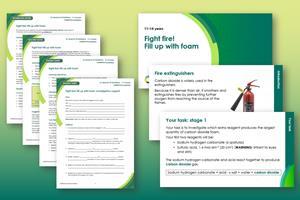Save the day, and put out a fire with this investigation into carbon dioxide foam
This resource accompanies the Education in Chemistry article Chemicals that play with fire, where you can discover how chemistry keeps firefighters safe on the job.
The practical investigation is part of the In search of solutions collection. These problem-solving activities are designed to contextualise chemistry and engage learners in small group work. Visit this page for further tips and suggestions on how to use this collection of resources.
Learning objectives
- Plan an investigation to identify the reagent that produces the largest quantity of carbon dioxide foam.
- Record the investigation results and make a conclusion.
- Design a ‘foam launcher’ suitable for delivering the foam to a fire.
Suggested lesson plan
Start the lesson with the Fire stopper demonstration to show learners how carbon dioxide extinguishes fire by smothering the flames and preventing further oxygen from reaching the fire.
Introduce the task using the student sheet and slides for guidance. Show the learners the equipment and reagents that they will be testing. The task then falls into three stages: plan, experiment and make conclusions.
Investigation planning
Prior to starting any experiments, ensure learners have a clear plan to investigate which extra reagent produces the largest volume of carbon dioxide foam. Example results for the reagents are included in the teacher notes.
As learners discuss their plans, circulate to support and scaffold discussions. Ensure learners have drawn a suitable table to record their results. Confirm that learners are aware of the reagent hazard warnings and have included safety precautions in their plans. Prior to learners starting any practical work, risk assess their plans.
Scaffolding
In the planning stage, learners will apply their understanding of practical skills to a new situation, which they often find demanding. Use the additional investigation support sheet for learners requiring a scaffolded method, results table and conclusion.
Assessment
You can assess learner performance in several different ways. At the end of the session, a fun way to assess success would be to ask groups to set up and run their best reagent combinations to identify which one produced the most foam. Alternatively, learners could submit a full report, written independently or using the scaffolded investigation support sheet provided.
Once learners have completed their report, introduce the questions and challenge. If time does not allow, these sections could be set for homework.
Equipment
- Safety glasses
Per group
- One litre plastic measuring cylinder or
- One litre drinks bottle with the top cut off
- Measuring cylinder (25 cm3)
- Spatula
- Non-permanent marker pen and ruler
Reagents per group (with quantities to be used in each experiment)
- Sodium hydrogen carbonate powder (6 spatulas)
- Sulfuric acid, 1.4 mol dm-3 (20 cm3) (WARNING: irritant to eyes and skin)
- Washing detergent powder (6 spatulas) (WARNING: irritant to eyes and skin)
- Washing up liquid solution (20 cm3)
- Water (20 cm3)
Safety, preparation and disposal
Refer to the technician notes for the safety notes, preparation and disposal advice.
Read our standard health and safety guidance and carry out a risk assessment before running any live practical.
More resources
- Develop your learners’ practical planning skills further with the resources and ideas in this article from our Teaching Science Skills collection.
- Grab your learners’ attention using this demonstration which shows the danger of using water to extinguish a chip pan fire.
- Read around the topic and find out What state of matter is fire?
- Watch Charley’s job profile to find out how a patent attorney works with new inventions in chemistry.
- Extend your learners’ problem-solving skills with other activities from our In search of solutions collection.
Downloads
Fight fire teacher notes
Editable handout | Word, Size 0.51 mbFight fire teacher notes
Handout | PDF, Size 0.23 mbFight fire technician notes
Editable handout | Word, Size 0.43 mbFight fire technician notes
Handout | PDF, Size 0.19 mbFight fire student sheet
Editable handout | Word, Size 0.49 mbFight fire student sheet
Handout | PDF, Size 0.28 mbFight fire investigation support
Editable handout | Word, Size 0.43 mbFight fire investigation support
Handout | PDF, Size 0.13 mbFight fire slides
Presentation | PowerPoint, Size 0.69 mbFight fire slides
Presentation | PDF, Size 0.59 mb
Additional information
This resource is adapted from In search of solutions, ed. K. Davies, Royal Society of Chemistry, 1990. The experiment was based on an idea contributed by I.M. Childs/M. Goodall.
The resource was reviewed and updated in 2023 with additional material added by Catherine Smith and Sandrine Bouchelkia.



















No comments yet